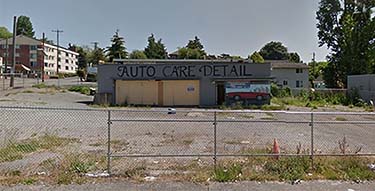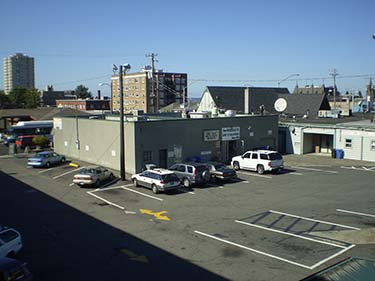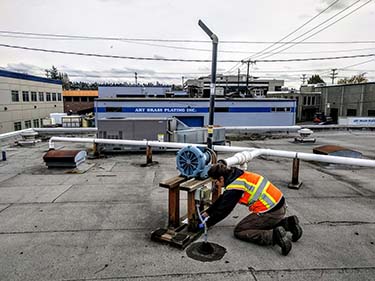|
Subscribe / Renew |
|
|
Contact Us |
|
| ► Subscribe to our Free Weekly Newsletter | |
| home | Welcome, sign in or click here to subscribe. | login |
Architecture & Engineering
| |
 |
March 4, 2021
What if you can’t dig your way out of a brownfield cleanup?
Aspect Consulting

Griffin
|

Hillman
|
Months matter for commercial real estate. Transaction timelines, construction schedules and operational changes all favor swift and certain schedules. Inserting an environmental cleanup into the equation complicates everything. Are you only dealing with accessible soil contamination? Get ready to dig. In Puget Sound soils deposited by glaciers, excavation is the cleanup scenario that provides the most certainty allowing for smooth construction and development — and one that may only take a few months to execute from planning to completion. Problem managed; crisis averted.
But what if cleanup via excavation isn’t enough to deliver your project? This is typically the case when environmental impacts extend to soil in inaccessible areas, or even more challenging, to groundwater. Instead of months, cleanups could potentially extend to years. However, there are ways to successfully tackle a more complicated cleanup in parallel with commercial and real estate activities.
Successful remediation beyond a straightforward dig requires a nuanced understanding of both the subsurface and, critically, cleanup regulations. Prior to deploying a remediation strategy, the remediation practitioner must identify what endpoint is required by regulation, and what is achievable with remediation technologies at the site. This remediation “due diligence” is essential for setting expectations for all project stakeholders.
INCREMENTAL STEPS
In Washington state, “No further action” letters from regulators are the widely accepted environmental cleanup endpoint to appease concerns and enable deals to move forward. Only focusing on the NFA milestone may work when you can dig your way to closure. However, for more complex projects, planning on intermediate milestones are critical to confirm the regulatory approval necessary to keep the commercial wheels moving forward while cleanup proceeds. Pursuing a cleanup strategy without getting regulatory buy-in along the way is a path that can lead to frustration and can wreak havoc with the best-laid construction and development plans. Here are some key regulator touch points that confirm cleanup complies with environmental regulations and is correctly headed towards the desired regulatory goal:
Mount Baker affordable housing redevelopment
GOAL: Cleanup to facilitate affordable housing redevelopment
CULPRIT: Dry cleaning solvents
CAN’T DIG: Contamination extends off-property beyond shoring limits
CLEANUP SOLUTION: In situ chemical treatment adjacent to shoring and prior to foundation construction
KEYS TO SUCCESS: Coordinating treatment with construction to reduce long-term groundwater management
• Approval of Interim cleanup actions that range in scale from source control to property footprint cleanup in conjunction with construction.
• Agreement on the final cleanup action as early as possible. Early alignment with the regulator on the selected cleanup is required to meet development timelines and culminates in the approval of a final cleanup action plan.
• Confirmation that exposure pathways (e.g., vapor intrusion) are protected as work proceeds. Early identification and potential mitigation of any completed exposure pathways limits potential liabilities.
Choosing the appropriate cleanup technologies is only one element of the solution. Industry experience has proven that inadequate site characterization is the leading cause of remediation failure. Understanding a site’s soil and groundwater conditions in the glacial depositional history of the Puget Sound requires regional geology and hydrogeology practitioners familiar with the geologic nuances of our region. When digging isn’t an option, complete site characterization is fundamental to successful in place or “in situ” remediation.
Addressing the source of contamination is the first step, and excavation/removal from the site is the default method. However, for contaminated soils that are infeasible to physically remove through excavation — in situ stabilization/solidification (ISSS) and thermal (i.e., heating the subsurface to break down contaminants) are two alternative remediation technologies. ISSS prevents the leaching of contaminants from soils to groundwater through physical solidification or chemical stabilization. ISSS can also provide ground improvement and achieve geotechnical objectives for redevelopment.
Thermal remediation is a broad class of remediation technologies that can be applied to volatile contaminants (e.g., dry cleaning solvents and fuel compounds) and provide a high degree of performance certainty but typically requires one year or more of operation for treatment. As an alternative to excavation, thermal remediation technologies can provide economy in scale on larger cleanups.
Contaminated groundwater greatly increases cleanup complexity and the potential for third party liability as it can migrate off property. Because groundwater remediation requires more time, it is often important that cleanup can proceed without disrupting commercial operations. Think creatively about how and where to access the plume — such as street rights of way or opportunistically from the excavation subgrade during construction.
GOAL: Cleanup while active retail continues
CULPRIT: Dry cleaning solvents
CAN’T DIG: Fully developed and active shopping center and deep groundwater contamination
CLEANUP SOLUTION: In situ treatment beneath dry cleaner, injection-based treatment on adjacent parcels
KEYS TO SUCCESS: Use parcel-specific NFAs to enable series of sales
The use of in situ remediation techniques are essential for groundwater remediation. Keep in mind realistic in situ strategies that include initial construction as well as routine monitoring and operations and maintenance plans. Promising technologies are available, including:
• Bioremediation. Microbiological communities that are naturally occurring to a site can be used to degrade contaminants in groundwater under aerobic and anaerobic conditions. These communities are often relied on for monitored natural attenuation (MNA) remedies but can also be engineered and activated through the addition of food-grade or commercially available reagents. Bioremediation treats contaminants in situ and can represent a viable remediation technology for sites with minimal disruptions above grade.
GOAL: Cleanup while continuing operations
CULPRIT: Degreasing solvents
CAN’T DIG: Groundwater plume extends beneath more than a dozen properties
CLEANUP SOLUTION: In situ treatment beneath plant, injection treatment in rights of way
KEYS TO SUCCESS: Investigate subsurface early; regulatory buy-in before implementation
• Chemical remediation. These technologies generally represent a “heavier hammer” for remediation — implementation costs are higher but treatment timeframes are shorter. Chemical oxidation is a staple remediation technology capable of directly treating contaminants. The applicability of chemical oxidation has a small “strike zone” but is still a unique and effective technology in the toolbox. Chemical reduction is a remediation technology that has also been developed as an alternative to bioremediation for solvents and reduces the generation of degradation products that can dictate cleanup timeframes.
All biological and chemical technologies require the successful delivery and distribution of reagents in the subsurface, which reiterates the importance of site characterization and establishment of regulatory endpoints for cleanup early in the project.
THE CLEANUP GOAL
When digging isn’t an option, these above steps set developers, the community, and project stakeholders up for successful realization of end goals — whether it’s keeping current business operations going or delivering a “clean” site so construction teams can achieve built construction on time and budget. The common theme in our experience — particularly in the project stories above — is thorough site characterization and early and often regulatory communication leads to successful cleanup and project outcomes.
Adam Griffin is an associate engineer at Aspect Consulting. Doug Hillman is an owner and principal hydrogeologist at Aspect.
Other Stories:
- How to keep the creative spark in a virtual world
- The role of ventilation and healthy air
- It’s the end of the grocery store (as we know it)
- Are American shopping malls boxed-in?
- Influencing human scale, creating a sense of place
- Here are the 3 principles of renovation
- The future of resilient commercial real estate
- Not all feasibility studies are created equal
- Green Lake Community Center aims for inclusivity
- How A/E firms can increase proposal success in 2021
- 4 Living Buildings: collaborative, courageous, open-minded learning
- Workplace wellness through technology
- Foundations for healthy and sustainable urban places
- Parking garages: rethinking your front door
- A changed workforce and the implications for workplaces and cities






